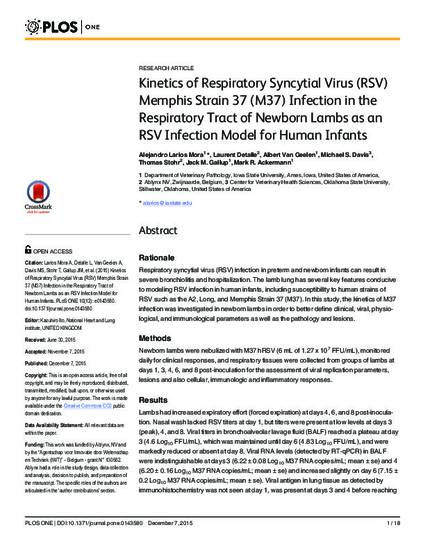
Article
Kinetics of Respiratory Syncytial Virus (RSV) Memphis Strain 37 (M37) Infection in the Respiratory Tract of Newborn Lambs as an RSV Infection Model for Human Infants
PLoS ONE
Document Type
Article
Disciplines
Publication Version
Published Version
Publication Date
12-7-2015
DOI
10.1371/journal.pone.0143580
Abstract
Rationale
Respiratory syncytial virus (RSV) infection in preterm and newborn infants can result in severe bronchiolitis and hospitalization. The lamb lung has several key features conducive to modeling RSV infection in human infants, including susceptibility to human strains of RSV such as the A2, Long, and Memphis Strain 37 (M37). In this study, the kinetics of M37 infection was investigated in newborn lambs in order to better define clinical, viral, physiological, and immunological parameters as well as the pathology and lesions.
Methods
Newborn lambs were nebulized with M37 hRSV (6 mL of 1.27 x 107 FFU/mL), monitored daily for clinical responses, and respiratory tissues were collected from groups of lambs at days 1, 3, 4, 6, and 8 post-inoculation for the assessment of viral replication parameters, lesions and also cellular, immunologic and inflammatory responses.
Results
Lambs had increased expiratory effort (forced expiration) at days 4, 6, and 8 post-inoculation. Nasal wash lacked RSV titers at day 1, but titers were present at low levels at days 3 (peak), 4, and 8. Viral titers in bronchoalveolar lavage fluid (BALF) reached a plateau at day 3 (4.6 Log10 FFU/mL), which was maintained until day 6 (4.83 Log10 FFU/mL), and were markedly reduced or absent at day 8. Viral RNA levels (detected by RT-qPCR) in BALF were indistinguishable at days 3 (6.22 ± 0.08 Log10 M37 RNA copies/mL; mean ± se) and 4 (6.20 ± 0.16 Log10 M37 RNA copies/mL; mean ± se) and increased slightly on day 6 (7.15 ± 0.2 Log10 M37 RNA copies/mL; mean ± se). Viral antigen in lung tissue as detected by immunohistochemistry was not seen at day 1, was present at days 3 and 4 before reaching a peak by day 6, and was markedly reduced by day 8. Viral antigen was mainly present in airways (bronchi, bronchioles) at day 3 and was increasingly present in alveolar cells at days 4 and 6, with reduction at day 8. Histopathologic lesions such as bronchitis/bronchiolitis, epithelial necrosis and hyperplasia, peribronchial lymphocyte infiltration, and syncytial cells, were consistent with those described previously for lambs and infants.
Conclusion
This work demonstrates that M37 hRSV replication in the lower airways of newborn lambs is robust with peak replication on day 3 and sustained until day 6. These findings, along with the similarities of lamb lung to those of infants in terms of alveolar development, airway branching and epithelium, susceptibility to human RSV strains, lesion characteristics (bronchiolitis), lung size, clinical parameters, and immunity, further establish the neonatal lamb as a model with key features that mimic RSV infection in infants.
Rights
This is an open access article, free of all copyright, and may be freely reproduced, distributed, transmitted, modified, built upon, or otherwise used by anyone for any lawful purpose. The work is made available under the Creative Commons CC0 public domain dedication
Language
en
File Format
application/pdf
Citation Information
Alejandro Larios Mora, Laurent Detalle, Albert G. van Geelen, Michael S. Davis, et al.. "Kinetics of Respiratory Syncytial Virus (RSV) Memphis Strain 37 (M37) Infection in the Respiratory Tract of Newborn Lambs as an RSV Infection Model for Human Infants" PLoS ONE Vol. 10 Iss. 12 (2015) p. e0143580 Available at: http://works.bepress.com/jack_gallup/40/

This article is from PLoS ONE 10(12): e0143580. doi:10.1371/journal.pone.0143580.